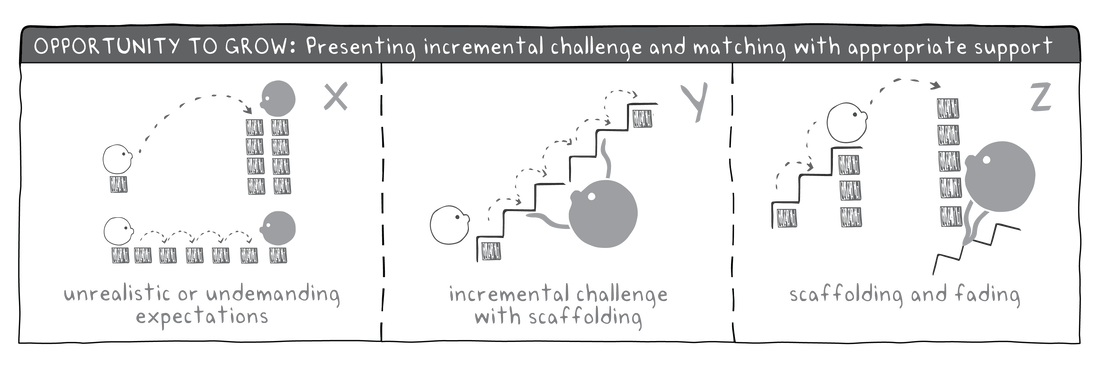Opportunity to grow
Teaching and learning happen when adults interact with children by offering both challenges and support. In an interaction, it is possible to identify whether children are afforded the opportunities to make progress, even if progress is not immediately visible. It also helps to be open-minded about what can be developed in a particular interaction: content knowledge, procedural skill, social and emotional capacity, trust, confidence, and much more. Just because we are observing a math class does not mean only math skills are developing, and just because we are observing a play session does not mean only social-emotional capacity are growing.
Common modes of interaction within Opportunity to Grow include:
The illustration of this dimension is very closely modeled after Lev Vygotsky’s classical definition of “Zone of Proximal Development” in constructivist learning theory. It is actually not common to explicitly include learning processes when assessing the quality of interactions and relationships. Relationship-focused tools sometimes omit the teaching, learning, and instructional components, or keep them separate from dimensions of feelings and emotions. From our fieldwork, we become convinced that interactions for learning and teaching are woven into feelings, agency, and belonging, and vice versa. Students do not just feel recognized when a teacher says hello at the door, but also when the teacher acknowledges their effort on the homework and test, pushes them to think deeper (because the teacher believes in them), or matches demanding learning challenges with both instructional and emotional support.
Teaching and learning are not separate from feeling and connecting. In fact, all four dimensions are distinct from one another yet interdependent with each other. Once, a workshop participant asked, “How can we make sure the 4 dimensions do not become yet another checklist of four boxes?” What a good question! The best imagery - since this tool is visual to begin with - we could come up is to think of each dimension as a thread of a unique color, the interaction as the process of weaving together four different threads, and the relationship as the strong and tightly-braided string.
Common modes of interaction within Opportunity to Grow include:
- X: An adult assigns children unreachable tasks without any support, or repeats unchallenging tasks.
- Y: An adult provides incrementally more difficult challenges and scaffolds children for steady progress.
- Z: An adult stretches children with a desirable level of difficulty that pushes them beyond their comfort zones. As appropriate, the adult withdraws (fades) some of the scaffolds children have gotten used to in Y.
The illustration of this dimension is very closely modeled after Lev Vygotsky’s classical definition of “Zone of Proximal Development” in constructivist learning theory. It is actually not common to explicitly include learning processes when assessing the quality of interactions and relationships. Relationship-focused tools sometimes omit the teaching, learning, and instructional components, or keep them separate from dimensions of feelings and emotions. From our fieldwork, we become convinced that interactions for learning and teaching are woven into feelings, agency, and belonging, and vice versa. Students do not just feel recognized when a teacher says hello at the door, but also when the teacher acknowledges their effort on the homework and test, pushes them to think deeper (because the teacher believes in them), or matches demanding learning challenges with both instructional and emotional support.
Teaching and learning are not separate from feeling and connecting. In fact, all four dimensions are distinct from one another yet interdependent with each other. Once, a workshop participant asked, “How can we make sure the 4 dimensions do not become yet another checklist of four boxes?” What a good question! The best imagery - since this tool is visual to begin with - we could come up is to think of each dimension as a thread of a unique color, the interaction as the process of weaving together four different threads, and the relationship as the strong and tightly-braided string.
Opportunity to grow in motion
|
|
|
|


